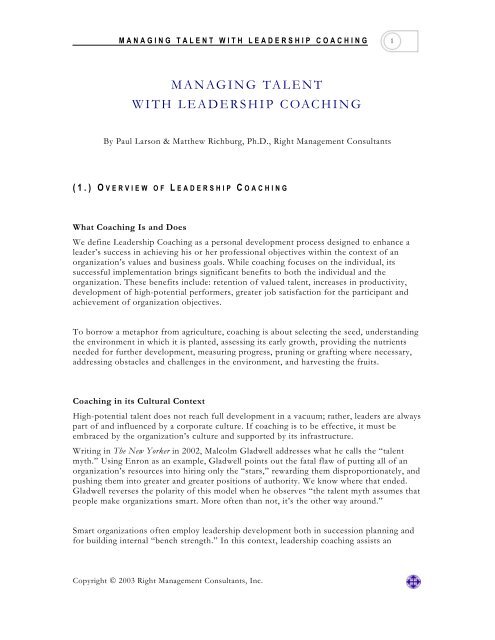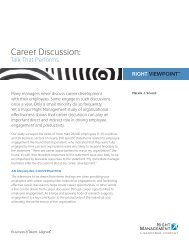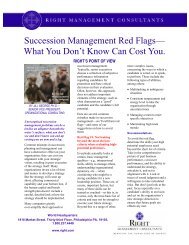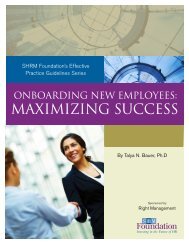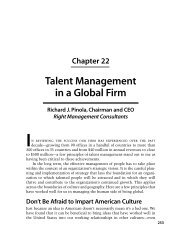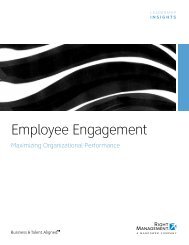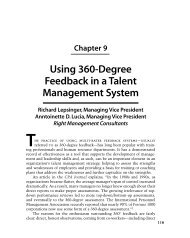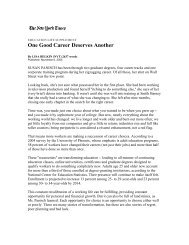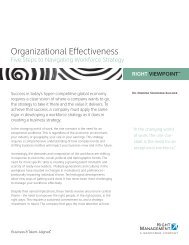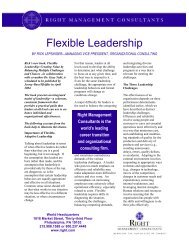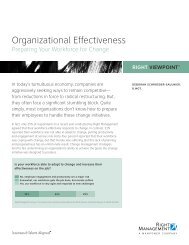TABLE OF CONTENTS - Right Management
TABLE OF CONTENTS - Right Management
TABLE OF CONTENTS - Right Management
Create successful ePaper yourself
Turn your PDF publications into a flip-book with our unique Google optimized e-Paper software.
MANAGING TALENT WITH LEADERSHIP COACHING<br />
MANAGING TALENT<br />
WITH LEADERSHIP COACHING<br />
By Paul Larson & Matthew Richburg, Ph.D., <strong>Right</strong> <strong>Management</strong> Consultants<br />
(1.) OVERVIEW <strong>OF</strong> L EADERSHIP C OACHING<br />
What Coaching Is and Does<br />
We define Leadership Coaching as a personal development process designed to enhance a<br />
leader’s success in achieving his or her professional objectives within the context of an<br />
organization’s values and business goals. While coaching focuses on the individual, its<br />
successful implementation brings significant benefits to both the individual and the<br />
organization. These benefits include: retention of valued talent, increases in productivity,<br />
development of high-potential performers, greater job satisfaction for the participant and<br />
achievement of organization objectives.<br />
To borrow a metaphor from agriculture, coaching is about selecting the seed, understanding<br />
the environment in which it is planted, assessing its early growth, providing the nutrients<br />
needed for further development, measuring progress, pruning or grafting where necessary,<br />
addressing obstacles and challenges in the environment, and harvesting the fruits.<br />
Coaching in its Cultural Context<br />
High-potential talent does not reach full development in a vacuum; rather, leaders are always<br />
part of and influenced by a corporate culture. If coaching is to be effective, it must be<br />
embraced by the organization’s culture and supported by its infrastructure.<br />
Writing in The New Yorker in 2002, Malcolm Gladwell addresses what he calls the “talent<br />
myth.” Using Enron as an example, Gladwell points out the fatal flaw of putting all of an<br />
organization’s resources into hiring only the “stars,” rewarding them disproportionately, and<br />
pushing them into greater and greater positions of authority. We know where that ended.<br />
Gladwell reverses the polarity of this model when he observes “the talent myth assumes that<br />
people make organizations smart. More often than not, it’s the other way around.”<br />
Smart organizations often employ leadership development both in succession planning and<br />
for building internal “bench strength.” In this context, leadership coaching assists an<br />
Copyright © 2003 <strong>Right</strong> <strong>Management</strong> Consultants, Inc.<br />
1
MANAGING TALENT WITH LEADERSHIP COACHING<br />
organization in using its resources optimally to assure that the group has: The right number<br />
of people, possessing the right kind of talent, at the right skill levels, in the right positions,<br />
at the right time and in the right geographic locations. Gaining bench superiority means<br />
nourishing inherent strengths and correcting weaknesses, where possible. Done right,<br />
coaching accomplishes both.<br />
Speaking at a seminar hosted by the Professional Coaches and Mentors Association in 2002,<br />
Coach Julio Olalla described how coaching works. He drew these distinctions: Teaching<br />
addresses information; training addresses action; coaching addresses observations.<br />
Transformational learning takes place in organizations when we have a conversation that<br />
causes us to look at things differently. In Olalla’s model, we observe, we take action, and we<br />
get results. However, when our results aren’t what we wish, we go back and change our<br />
actions. A coach will cause the leader to reflect on the original observations and thereby<br />
produce a change in action. The evaluation of observations or review of actions takes place<br />
in coaching conversations – a vital concept explored in this chapter.<br />
The culture and infrastructure of an organization must allow and support this conversation<br />
if transformational learning is to happen. Laurence Lyons, in his book Coaching for Leadership<br />
(co-edited with Marshal Goldsmith and Alyssa Freas), calls these conversations a structured<br />
dialogue. As he writes, “…dialogue is at the heart of coaching… the coach has no corporate<br />
authority whatever. But through dialogue alone, the external coach exercises considerable<br />
influence. With neither formal authority nor direct accountability, the coach’s greatest<br />
ambition is to profoundly affect the way the executive thinks and behaves.”<br />
In this coaching equation, it is important to note two operational characteristics of the<br />
relationship. 1. The outside coach should have no personal agenda. The coach’s job is to<br />
objectively manage the delicate balance of addressing effective business outcomes alongside<br />
the leader’s desired outcomes. [For consistency and clarity, throughout this chapter, we will<br />
use the term “leader” to refer to the individual being coached.] 2. The outside coach should<br />
strive always for a relationship as partner, colleague, ally or equal – never as a “superior” or<br />
“authority.”<br />
QUOTE:<br />
“Coaching is an action-oriented partnership that, unlike psychotherapy which delves<br />
into patterns of the past, concentrates on where you are today and how you can reach<br />
your goals.”<br />
Copyright © 2003 <strong>Right</strong> <strong>Management</strong> Consultants, Inc.<br />
2<br />
- Time, 10/16/00
MANAGING TALENT WITH LEADERSHIP COACHING<br />
(2.) THE C ASE FOR C OACHING<br />
Coaching Catches On<br />
In recent years, interest in executive coaching has exploded. More organizations are using<br />
coaches, and coaching has attained widespread acceptance as a powerful and legitimate<br />
intervention. Why this popularity? We asked attendees at a series of executive briefings on<br />
leadership coaching, and they noted these primary reasons:<br />
- Jobs are more complex.<br />
- Leadership challenges are more complex.<br />
- Feedback is needed, yet rarely received.<br />
- Organizations have a flatter structure, so “people issues” are even more important.<br />
- During periods of rapid change, effective leadership is more important than ever.<br />
- People are more open to outside help; some even welcome it.<br />
- It is a sound investment.<br />
The last one rings a loud bell for most organizations. Hiring a coach means an investment of<br />
an organization’s time and resources. Since so many leaders are using a coach, there must be<br />
a convincing case for coaching. There is: Quite simply, coaching works. And when it works<br />
well, it raises both individual performance outcomes and their implied operational<br />
efficiencies and bottom-line reflections for the organization.<br />
QUOTE:<br />
“The ROI with executive coaching is often very high – especially if you calculate the<br />
value of high-level executive salary and the return-on-improvement in skill level and<br />
decision making.”<br />
- Training & Development, 3/1/99<br />
C OACHING W ORKS: REAPING R ETURNS ON I NVESTMENT<br />
Effective professional coaching enhances leadership performance and, ultimately,<br />
profitability. Here’s why.<br />
A synergistic and focused relationship leads to growth and change. The relationship<br />
between the coach and the leader is a powerful tool – there is accountability, candid<br />
Copyright © 2003 <strong>Right</strong> <strong>Management</strong> Consultants, Inc.<br />
3
MANAGING TALENT WITH LEADERSHIP COACHING<br />
conversation and trust (embedded in the confidential nature of the relationship) that<br />
facilitate personal growth.<br />
Clear goals and a focused endeavor lead to better outcomes. The old saying goes, “When<br />
you don’t know where you’re going, any road will do.” The same applies to coaching. The<br />
focused nature of coaching facilitates learning that readily impacts leadership behavior and<br />
the bottom line.<br />
Coaching is contextual. Because coaching occurs in the context of work, it is tied to realworld<br />
issues and is relevant to the business and to the culture/competencies of the<br />
organization. Accordingly, it affords opportunities for growth that are inherently tied to the<br />
goals and objectives of the organization.<br />
Coaching is a systemic intervention with multiplier results. Effective coaches include the<br />
perspectives of the leader’s boss and those of important colleagues, so that development<br />
occurs system wide. When one leader improves her performance, benefits ripple out to her<br />
team, her peers and other departments. The return on investment grows.<br />
Coaching focuses on using new skills and more effective behaviors. A coaching relationship<br />
allows for behavioral change in a “safe” nurturing environment that provides a real<br />
opportunity to practice new skills. Successes are rewarded and feedback is provided for<br />
ongoing corrections. Because most development is incremental rather than revolutionary, a<br />
coach can reinforce successful growth and continue to move the performance targets<br />
forward.<br />
Executive development occurs through insight and with practice -- not theoretically, but<br />
applied on the job under real-world conditions.<br />
Coaching helps leaders develop emotional intelligence. Recent research strongly suggests<br />
that emotional intelligence forms the base of effective leadership. Emotional intelligence<br />
differs from conventional analytic and technical ability, and it is apparently best served by an<br />
individualized approach that incorporates extended practice and feedback. Coaching<br />
provides a framework for recognizing and working with the drives and feelings in oneself<br />
and in others.<br />
Coaching impacts the bottom line. Leaders whose work is satisfying are more effective and<br />
more productive. While measurable data may be in short supply, most of us have witnessed<br />
this “expansion affect” in the workplace when coaching does its job.<br />
Copyright © 2003 <strong>Right</strong> <strong>Management</strong> Consultants, Inc.<br />
4
MANAGING TALENT WITH LEADERSHIP COACHING<br />
(3.) THE COACHING P ROCESS<br />
The goal of coaching is to increase the effectiveness of the organization’s leadership talent<br />
through interactive guidance and learning. This achievement, in turn, helps assure greater<br />
success for the organization as a whole. Coaching methodology can be used to develop the<br />
leadership skills of executives, managers, professionals and other promising leaders at all<br />
levels. While details vary to suit characteristic levels, our coaching process assumes this basic<br />
format:<br />
The coaching process at our organization begins by enrolling the individual leader who is to<br />
be coached. The client organization usually selects these leaders in consultation with the<br />
coaching consultant, based on factors such as corporate goals, affected levels of leadership<br />
influence, needs of specific individuals and their direct reports, and other salient<br />
considerations.<br />
The coach and the leader then meet and begin building a relationship of trust by examining<br />
their respective roles and mutual goals. The coach explains the process, sets and fine-tunes<br />
expectations, addresses confidentiality and gains the leader’s commitment. To further build<br />
trust, the coach openly discusses his or her experience and background and, through oneon-one<br />
meetings, discusses the leader’s context, issues, misgivings and questions while<br />
exchanging organizational information and getting well acquainted.<br />
In fact-finding and feedback sessions, the coach and the leader review various assessment<br />
data and select leadership tools, techniques and exercises to use in the coaching process.<br />
Copyright © 2003 <strong>Right</strong> <strong>Management</strong> Consultants, Inc.<br />
5
MANAGING TALENT WITH LEADERSHIP COACHING<br />
During this phase, the coach may “shadow” the leader to see leadership principles applied in<br />
everyday situations, such as meetings with bosses, peers and subordinates.<br />
Together, the coach and the leader create a development plan that guides their progress.<br />
They identify areas of strength and those that require additional development. They also<br />
prepare to review their plan with the organization’s decision maker.<br />
Then, after agreeing on basic approaches, the main work begins: coaching to the<br />
development plan. The coach mentors the leader, tracks behaviors and behavioral changes,<br />
and gives constructive feedback in a way that supports positive change. The coach also<br />
verifies methods to measure the leader’s progress.<br />
As the coaching experience produces the desired results, it’s time for closure and evaluation<br />
of the process. The coach and the well-coached leader review joint accomplishments relative<br />
to stated objectives and develop long-term goals for the client’s continued growth. The<br />
coach then confirms results with the organization’s decision maker, explains their plan for<br />
next steps, and gets commitment for ongoing support of the leader.<br />
(4.) COMMON C ONDITIONS FOR C OACHING<br />
QUOTE:<br />
“Inside every successful business person is an even more ambitious one trying to get<br />
out. He or she just needs a little help.”<br />
- Australian Financial Review, 10/9/00<br />
Many events and situations merit the constructive intervention of coaching. Consider these<br />
scenarios:<br />
The organization has hired a new Chief Operating Officer to engineer a turnaround of a<br />
significant operating loss. Coaching can help the new COO align quickly with the<br />
organization and work with many levels of personnel to accomplish business objectives.<br />
Chafing under a new boss, a valued member of executive management appears to be taking<br />
his difficulty out on subordinates. Coaching can help the executive understand what’s<br />
happening, why, and how to get his career back on track and rebuild relationships.<br />
Copyright © 2003 <strong>Right</strong> <strong>Management</strong> Consultants, Inc.<br />
6
MANAGING TALENT WITH LEADERSHIP COACHING<br />
The company wants to promote a seasoned manager to direct a large and complex line of<br />
business. Coaching and assessment processes can be offered to help ensure her successful<br />
transition into deeper waters and to use her strengths to navigate uncharted territory.<br />
A longtime CEO with a history of success is two years away from retirement. Now’s the<br />
time for succession planning, beginning with the CEO’s favorite candidate. Through<br />
assessment and coaching, this leader can gain competencies and confidence to step into large<br />
shoes while cultivating supportive relationships with staff.<br />
A superior analyst and technician, the CFO is a demanding boss who alienates subordinates,<br />
sending turnover rates through the roof. Coaching can help rehabilitate and “save” this<br />
valuable resource through a sensitive program of behavioral change and accommodation to<br />
the needs and feelings of others.<br />
(5.) CATEGORIES <strong>OF</strong> L EADERS AND A TTRIBUTES <strong>OF</strong> C OACHING<br />
Because there are different kinds of leaders who are at various levels of development or<br />
potential, it is important to attempt to define each case accurately before beginning the<br />
process. Other sections of this book set forth and define a useful framework of categories<br />
based on degree of perceived leadership effectiveness, ranging from Misfit to Solid Citizen,<br />
to Keeper, to Superkeeper. Another metric, which we find essential in our work, is the<br />
degree of impact the leader is having on the organization—which might be said to be a<br />
combination of level or position in the organization, and his or her stage of professional<br />
development. The categories of this metric are Emerging, Developing, and Strategic. The<br />
diagram on the next page illustrates how these concepts inter-relate.<br />
Copyright © 2003 <strong>Right</strong> <strong>Management</strong> Consultants, Inc.<br />
7
Super-<br />
Keeper<br />
Keeper<br />
Solid<br />
Citizen<br />
Misfit<br />
Increasing Leadership Effectiveness<br />
MANAGING TALENT WITH LEADERSHIP COACHING<br />
Emerging<br />
Superkeeper<br />
Emerging<br />
Keeper<br />
Emerging<br />
Solid Citizen<br />
Emerging<br />
Misfit<br />
Developing<br />
Superkeeper<br />
Developing<br />
Keeper<br />
Developing<br />
Solid Citizen<br />
Developing<br />
Misfit<br />
Increasing Business Impact<br />
Strategic<br />
Superkeeper<br />
Strategic<br />
Keeper<br />
Strategic<br />
Solid Citizen<br />
Strategic<br />
Misfit<br />
Emerging Developing Strategic<br />
Obviously, there are many possible permutations in the way one would approach coaching<br />
various types of individuals, and that approach would be influenced by their positioning in<br />
the organization. The sections that follow, however, focus on describing the rationale,<br />
coaching actions, and outcomes typically represented at each of the three broad levels of<br />
business impact, and gives real examples from our practice of how the coaching process has<br />
played out with individuals falling within each category.<br />
Emerging Leader. The business case for engaging a coach at this level might be to meet<br />
succession needs, to groom a high-potential leader or to help drive the organization to a<br />
different plane.<br />
Copyright © 2003 <strong>Right</strong> <strong>Management</strong> Consultants, Inc.<br />
8
MANAGING TALENT WITH LEADERSHIP COACHING<br />
Expected outcomes might include retention, readiness for upward mobility and improved<br />
chances for success in the next position. Here the coaching conversation might include:<br />
- Self-understanding and insight through feedback<br />
- Exposure to new behavioral concepts and broader organizational awareness<br />
- Exposure to how the business world works at the top<br />
- Learning organizational and individual tolerance to change<br />
- Learning to share the spotlight<br />
Example:<br />
A large manufacturing firm had identified thirty high-potential executives, one of whom was a young<br />
engineer who embodied many of the qualities the company needed to become more lean, nimble, and<br />
innovative. They initiated a coaching relationship to prepare him for greater responsibility and the<br />
opportunity to make a significant contribution. The coach implemented a thorough program of assessments<br />
of the executive and those around him.<br />
This process confirmed strengths and highlighted limitations to be addressed. The leader in<br />
question was shown to be not tough enough and not consistent in the messages he<br />
communicated to his people. He would get good ideas but did not follow them through or<br />
convey them effectively over time. The coaching process brought new focus and direction to<br />
his work. He was given more opportunity to be exposed to senior management and to<br />
organizational strategy and, more importantly, to see his own work in the context of that<br />
strategy. He mapped out a clear career path to take him where he needed to go, which<br />
resulted in his becoming the first person to make a cross-functional move in his company.<br />
Since the coaching experience, he has been promoted twice and has developed a personal<br />
working relationship with the CEO.<br />
Developing Leader. In a typical scenario, this valuable leader is a great thinker but may not<br />
be adept at mobilizing others or addressing practical consequences. This leader might be a<br />
nonconformist or loner. The business case for coaching intervention is obvious: To address<br />
performance issues that are impacting the business. The desired outcomes are improved<br />
performance, retention, and strengthened relationships with key stakeholders, such as the<br />
board. Here the coaching conversation and activities might tap into many components:<br />
- Gaining self-understanding and insight<br />
- Changing specific behaviors, notably addressing derailment behaviors<br />
- Addressing the immediate concerns of the leader within the context of<br />
organizational issues<br />
- Facilitating stronger bonds with the boss, peers, directors and others<br />
Copyright © 2003 <strong>Right</strong> <strong>Management</strong> Consultants, Inc.<br />
9
MANAGING TALENT WITH LEADERSHIP COACHING<br />
- Offering sounding-board opportunities to air frustrations, successes and challenges<br />
to the corporate culture<br />
Example:<br />
A finance executive at the director level of a public company wanted to become a vice president but was at a<br />
standstill. He was an MBA in a blue-collar environment, and those at the VP level perceived him to be an<br />
empire builder. He badly wanted to keep from derailing his career, but aspects of his behavior were causing<br />
serious relationship problems with the VPs. The company wanted to help him succeed and to become more<br />
effective and productive in his job.<br />
The coaching process had to be done confidentially, involving only the executive, HR, his<br />
boss, and the CEO. Because this constraint prevented using the normal 360-degree<br />
assessment, the coach devised an “introspective 360” process involving journaling to<br />
examine a number of key events to see who was thinking what, how people reacted to each<br />
other, what alternative strategies might be employed and what the actual outcomes might be.<br />
This technique enabled the leader to see how he was being perceived and what he had to do<br />
to change this perception, most notably his communication style. He was assigned a major<br />
project that provided him with a key opportunity to prove himself to his colleagues. He was<br />
highly successful in this role and able to demonstrate company-wide coordinating<br />
capabilities in a highly visible arena, through which he gained the respect of those who had<br />
previously not liked or trusted him. As a result, he was promoted to vice president.<br />
Strategic Leader. The business case for engaging a coach at this point might be to assimilate<br />
new leaders or to build a more united executive team. The expected outcomes might be to<br />
generate more incisive strategic thinking, to improve senior-level bench strength and to<br />
retain valued talent. Here the coaching conversation focuses on:<br />
- Thinking more strategically<br />
- Building specific skills, such as constructive confrontation<br />
- Developing leadership skills<br />
- Providing a sounding board<br />
Example:<br />
A CEO of a large organization was floundering. Key issues included poor stakeholder relations and<br />
organizational alignment. A vision was in place but the alignment was lacking because the CEO was<br />
unclear about the expectations of his board and therefore could not communicate these to other stakeholders.<br />
Copyright © 2003 <strong>Right</strong> <strong>Management</strong> Consultants, Inc.<br />
10
MANAGING TALENT WITH LEADERSHIP COACHING<br />
A coach was engaged to address the situation on multiple fronts. Assessments and<br />
interviews took place not only with the leader but also with multiple board members and<br />
eight staff members to achieve common understanding and agreement of what should be<br />
expected of the CEO. The process confronted interpersonal skills but also, to a large degree,<br />
systemic organizational and cultural issues that were preventing the CEO from functioning<br />
more effectively.<br />
The result was that the CEO improved dramatically in his ability to be leader to both the<br />
board and the rest of the organization. They achieved increased clarity regarding the board’s<br />
needs and expectations, permitting him to convey these and act upon them confidently with<br />
the full range of stakeholders with whom he worked. Four years later, he was still CEO and<br />
the organization had experienced impressive growth.<br />
(6.) ISSUES S URROUNDING C OACHING<br />
The consideration of coaching, or the initiation of a coaching relationship, sometimes raises<br />
a variety of issues. Here are some, with our thoughts on each.<br />
Will it work? When considering the use of coaching, some organizations are concerned that<br />
the process may not work. To handle doubts, we generally ask questions—coaching<br />
questions—to probe the resistance or problem. For instance, we ask: “Why do you think it<br />
might not work?” or “Are you prepared for it not to work?” At this point in the<br />
conversation, we can usually address the real reason for concern and move forward with a<br />
constructive coaching program<br />
What’s the Return on my Investment? One natural question pertains to whether anyone can<br />
prove that coaching provides a value to the organization at least equal to the investment<br />
required. Here we typically stimulate dialogue by encouraging an analysis of several factors:<br />
- What is the issue you are addressing?<br />
- What is the current situation relative to this issue?<br />
- What do you envision as the desired outcome?<br />
- What is preventing this desired outcome?<br />
We then discuss the estimated financial impact of not addressing the above issues, in very<br />
concrete terms. In other words, what would be the dollars lost in each of the following<br />
areas?<br />
Revenues $_____<br />
Profitability $_____<br />
Copyright © 2003 <strong>Right</strong> <strong>Management</strong> Consultants, Inc.<br />
11
MANAGING TALENT WITH LEADERSHIP COACHING<br />
Turnover of key people (total salaries X 2 =) $_____<br />
New product development $_____<br />
Missed market opportunities $_____<br />
Customer satisfaction $_____<br />
Other $_____<br />
Total estimated impact $_____<br />
While there is no guarantee of literal return on investment, an organization can often<br />
pinpoint with surprising specificity what the costs could be of not trying to address the<br />
problems at hand.<br />
What about Confidentiality? Confidentiality is fundamental to a successful working relationship<br />
between the coach and the leader. To make the kinds of progress toward personal growth<br />
and self-awareness that are central to coaching, the leader must be able to view the coach as<br />
a trusted confidante, with communications between them protected by the ethics of the<br />
relationship. We make the ground rules clear in advance – that a boss should not ask a coach<br />
to break this confidence to provide information to the organization, as any perceived gain to<br />
the organization would usually be more than offset by the subversive effect this would have<br />
on the coaching relationship.<br />
What is The Boss’s Role? The coach is in the center of a complex relationship that includes the<br />
individual being coached, his or her manager, Human Resources, other superiors, peers, or<br />
subordinates who may be involved in the feedback/assessment process. In this mix, the<br />
participation, commitment and support of the individual’s boss will make a huge difference<br />
in the success of the coaching. If the boss is unengaged or questions the value of the<br />
process, we take special pains to help the boss understand his key role both in providing<br />
important input to the assessment phase and in delivering feedback critical to the client’s<br />
self-awareness and progress. In truth, often a key goal of the coaching process is to improve<br />
the relationship between the boss and the leader being coached, as a leader’s ability to be<br />
effective in a particular job is most often closely tied to the quality of this relationship.<br />
The Merits of External versus Internal Coaches. Everyone in an organization has a personal<br />
agenda. Most people are genuine in their concern for their own best interests and the<br />
organization’s. Nevertheless, it is challenging for most of us when dealing with those with<br />
whom we work regularly not to let personal or political dynamics color the interaction. A<br />
coach coming from outside the organization will be less likely to have a personal agenda that<br />
would negatively impact the relationship. The coach’s primary agenda in this relationship<br />
must be consciously to balance the business concerns motivating the organization to initiate<br />
the coaching with the leadership and career objectives of the individual being coached.<br />
When the coach is positioned as a partner or equal—not as a “superior”—these critical<br />
Copyright © 2003 <strong>Right</strong> <strong>Management</strong> Consultants, Inc.<br />
12
MANAGING TALENT WITH LEADERSHIP COACHING<br />
organizational and individual priorities can take precedence and the process can proceed<br />
unimpeded.<br />
(7.) CONCLUSION<br />
Careful, responsible leadership coaching works. It works on several levels of learning. The<br />
first gain comes in the leader’s incremental improvement in skills and practices; then the<br />
reshaping of paradigms and patterns of thinking to include broader perspectives, different<br />
assumptions and an altered frame of reference. During the last phase of successful coaching,<br />
the leader will see and sense a transformation, a rewarding personal shift in point of view.<br />
The coaching process is designed to bring out the best in people, with a focus on business<br />
results. The organization benefits in definite recognizable ways from its investment in<br />
coaching, whether that success is assessed as an improved bottom line, higher employee<br />
morale, better employee relations or progress in other business indicators. At its best,<br />
coaching produces lasting value-added results for individuals and for their organizations<br />
while reinforcing and enriching the climate for continued success.<br />
QUOTE:<br />
“As a result of coaching, clients set better goals, take more action, make better<br />
decisions, and more fully use their natural strengths.”<br />
13<br />
Sausalito.net, August 2000<br />
SEVEN KEY ELEMENTS <strong>OF</strong> COACHING<br />
Effective coaching is not amorphous. It is grounded in certain basic understandings, which<br />
we call “The Seven C’s of Successful Coaching.”<br />
C ONTEXT.<br />
The coach is able to provide appropriate and meaningful support by understanding the<br />
issues within the context of the organization’s business environment, culture and<br />
competitive demands.<br />
Copyright © 2003 <strong>Right</strong> <strong>Management</strong> Consultants, Inc.
C LARITY.<br />
MANAGING TALENT WITH LEADERSHIP COACHING<br />
The participating leaders are able to clarify objectives, expectations for change, and how the<br />
coaching process will be conducted.<br />
C OMMITMENT.<br />
The organization is committed to supporting the leader, and the leader is committed to<br />
working for change.<br />
C OACHABILITY.<br />
The presenting issue and the people it affects are amenable to coaching, and the situation<br />
can best be addressed through one-on-one coaching. In reality, there are some situations<br />
where coaching would not be productive, and a responsible coach knows when to turn down<br />
an engagement on the basis of the coachability issue.<br />
C OURSES <strong>OF</strong> A CTION.<br />
The coach and the leader establish a development plan with clearly stated objectives and<br />
realistic strategies to help the leader become more effective.<br />
C ONFIDENTIALITY.<br />
A “must” of trust-building.<br />
C HEMISTRY.<br />
Leader/coach rapport and compatibility characterize interactions and secure the<br />
relationship.<br />
When leadership coaching meets this “7 C’s” criteria, transformational learning is not only<br />
possible but also probable. Some of the results are subtle, some are dramatic, including:<br />
- Incremental improvements such as upgraded skills, new practices and behaviors,<br />
doing things better, and relating to others with greater self-awareness.<br />
- Reshaped patterns of thinking, such as a revised frame of reference, a change in<br />
assumptions about how things work or how one sees the world.<br />
- Personal transformation, such as a shift in one’s point of view about “Who I Am”<br />
and “How I Am.”<br />
For more information on how <strong>Right</strong> can help your company manage talent with leadership<br />
coaching, call the world’s leading career transition and organizational consulting firm at<br />
1.800.237.4448.<br />
Copyright © 2003 <strong>Right</strong> <strong>Management</strong> Consultants, Inc.<br />
14


